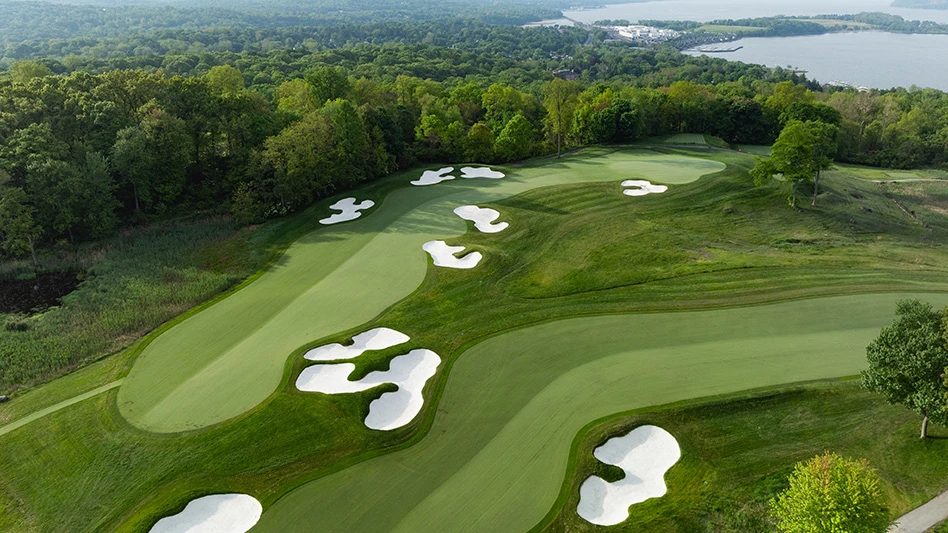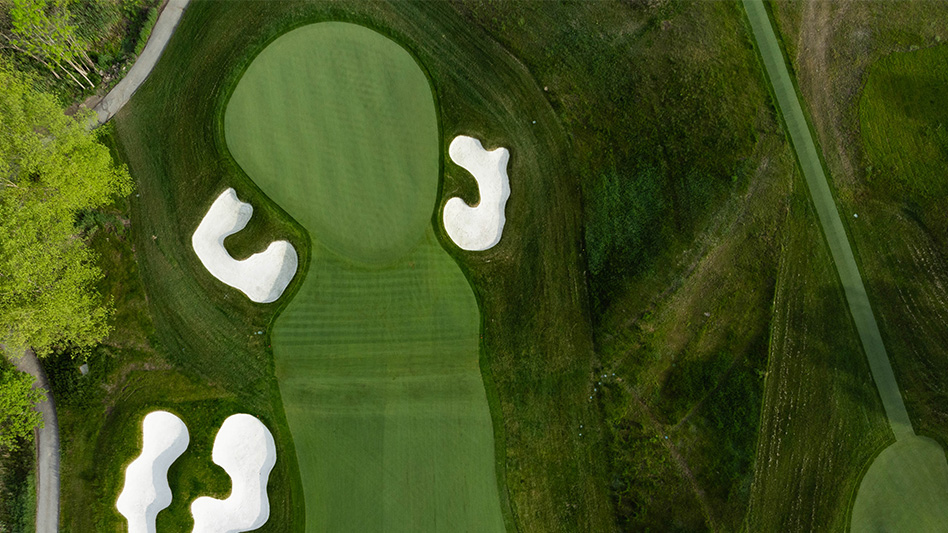
Courtesy of Hudson National Golf Club (2)
Hudson National Golf Club has unveiled its Fazio Design after a year-long closure for an extensive renovation. The club—located in Croton-on-Hudson, New York, 40 miles north of New York City — features expansive views from high above the Hudson River. The renovation included significant improvements to all 18 greens, bunkers, new grasses and irrigation, and a greater reliance on strategic decision-making.
“We were excited to work with Team Fazio and to recognize their enhanced vision for the golf course, making a great golf course even greater,” Hudson National President Phil Moyles said.
The renovation included:
- Emphasis on strategy for the longer hitter, to perhaps rethink the benefits of hitting a driver off each tee. With the driving distances now some 30 yards longer than when the course was first designed, The Fazio Team has defined the landing areas with a distinctly memorable pinch through relocated and new bunker locations at 315 yards to 340 yards off the tees.
- All 18 holes were rebuilt to USGA specifications. Most remain in their original locations, but some were moved, and a number redesigned with more contour. Further, a few greens were resized and/or reshaped to create new and more challenging hole locations, while others underwent changes to their surrounds, including the addition of low-mow areas.
- Tee placement and tee-shot strategy were key areas of interest, with a goal to give golfers more options. On Nos. 6,10,12 and 15, new back tees were added to lengthen holes. Throughout the course, bunkers were added, rebuilt or expanded into fairways.
- All the turfgrass was updated in the fairways and rough, with the bentgrass fairways and fescue/bluegrass rough seeded to new, improved varieties of each.
- Every bunker now has a Bunker Solution liner, to improve sand performance. More than 78 existing bunkers were rebuilt, and 12 fairway bunkers relocated further from the tee. New fairway bunkers were added to nine holes, while 15 existing ones were extended into areas of play, pinching landing areas for longer hitters.
- All 18 greens were regrassed with 007XL, an improved bentgrass created by Dr. Rich Hurley at Rutgers University.
- The entire irrigation system has been replaced.


While every hole was improved, a handful were treated to significant change, notably:
Hole 1. The green has been elongated back left to allow a new deeper hole location past the guarding front left bunker. The front of the green was moved 8 yards from the tee, adding length to the start of the green. Past the green, a new low-mow collection area is added on the edges of the extended back pin area.
Hole 3. The angled right-to-left green now features a new front right, expanded hole location backdropped by the back right bunker.
Hole 4. The green on this short par 4, which already had a false front, has been lengthened in the back to accommodate more hole positions. Going from two tiers to three puts more emphasis on finding the proper landing area with what should be a mid- to short-iron approach.
Hole 5. More challenge was added to this par 4 by enlarging a bunker on the left side of the fairway. The green has been redesigned and enlarged, and now is guarded on the left by a new bunker and closely mown collection area. The putting surface has more hole positions back left and back right, more distinct sections and undulations, and a more pronounced back-to-front slope.
Hole 6. The green is now surrounded by bentgrass with fall off slopes that feed the ball away from the putting surface.
Hole 7. The addition of a new sightline bunker at the crest of the hill squeezes the landing area, completely changing one’s approach to playing this shortish par 4, especially the longer hitter. For most players, the second shot will be downhill to an all-new green complex with more left-to-right slope and a large area of bentgrass low-mow slope on the right perimeter.
Hole 8. The green now retains the original 1995 contours in the middle that move the ball slowly to the edges, away from the flagstick.
Hole 9. The green features expanded bentgrass wrapping the back-right collar slopes that adds an infinity edge to the back pins.
Hole 13. The green is now protected on the right slopes, with bentgrass surrounds that roll the miss-hit approach down and away the collar.
Hole 14. The changes to the par 5 epitomize the work done throughout the course. What once were two sections of fairway have been connected, which could tempt players to try driving past the enlarged fairway bunker on the left in hopes of going for the green in two. The larger fairway also brings the large water hazard on the right into play on the second (or third, or fourth) shot, aided by some new layup bunkers left and center, and a berm about 90 yards out, which can hide the surface of the all-new long, narrow green from view. The green site was moved 20 to 25 yards back and right to wrap more around the water and is protected by new bunkers and low-mow turf on the left. Plus, a new tier has been added to the middle of the 45-yard-long green. Holes cut in the new back-right corner of the green will seem to be floating on the water.
Hole 18. The tee shot landing area is now protected with a narrowing of the fairway and a new left side bunker.
Hudson National has remained a golf-only club since its opening in 1996. Brett Scales is the club’s superintendent.
Latest from Golf Course Industry
- From the publisher’s pen: Conscientious of a bigger role
- Bernhard and Company partners with Laguna Golf Phuket
- Terre Blanche showcases environmental stewardship
- VIDEO: Introducing our December issue
- Bernhard and Company introduces Soil Scout
- Nu-Pipe donates to GCSAA Foundation’s Centennial Campaign
- GCSAA enhances golf course BMP tool
- Melrose leadership programs sending 18 to 2026 GCSAA Conference and Trade Show





